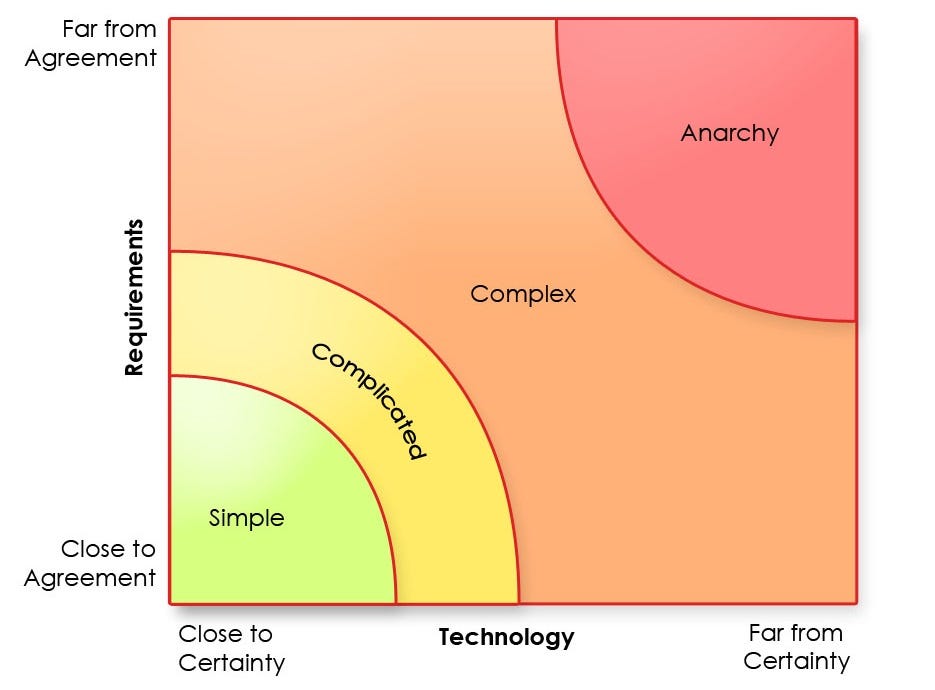Every professional marketer wants to be great at what they do and how they do it. The difference between great marketing teams — those who focus on not only better outcomes but on better ways of achieving those outcomes — and all other professional marketers is their determination to relentlessly navigate complexity together.
Understanding Uncertainty
No, that’s not an oxymoron; it is possible to understand uncertainty by defining what you do know versus what you do not know (yet). Said simply: knowing implies factual reference points whereas understanding is the ability to describe something holistically.
Uncertainty is a continuum; one can be ‘close to certainty’ or ‘far from certainty.’
In Marketing, uncertainty is often centered on technology — often called the marketing tech stack — which requires marketing teams to leverage many different software tools, platforms, and mediums to deliver results. The resulting complexity is not only in the number of tools required, but the disparity and difficulty of integrating the tech stack to deliver cohesive results.
Great marketing teams find ways to reduce complexity by either limiting the technology tools to a smaller number of simple tools which work well together or by investing into comprehensive technology software solutions which packs a number of key tools into a single product suite.
Other marketers allow the tyranny of the urgent to limit their ability to investigate and demonstrate technology solutions which deliver unified results. As a consequence, these marketers never gain the momentum to successfully understand uncertainty so that they can achieve breakthrough results.
Great marketing teams ruthlessly eliminate technologies and processes which impede their ability to deliver consistent and cohesive results.
Achieving Agreement
When requirements are set for a project, plan, or task, the requestor and the person/team doing the work either is ‘close to agreement’ or ‘far from agreement.’ For example, as often happens in Marketing, requests come in for work to be done with not much more than a notion of the desired result. This lack of clarity around the work scope, the needed output, and the desired outcome can lead to confusion around what was meant by the request and what was actually delivered by the Marketing team.
When a great marketing team has solid processes and open dialog channels with the stakeholders requesting projects, the better their chances of agreement on the requirements for the project which, of course, leads to better deliverables and, hopefully, more effective outcomes.
Great marketing teams work to build clarity by working on the business, not just in the business. These great teams value the overhead work on creating, working through, and improving the communication, processes, and systems to make aligning stakeholder requests with the key results of the business. This is purposeful work and is one of the main reasons these are great marketing teams.
Great marketing teams place a high value on aligning requirements with business outcomes.
Navigating Complexity
Great marketing teams navigate complexity by understanding uncertainty and achieving agreement within their team and with stakeholders in the business. How they do this is visually represented in the graph below called The Stacey Matrix.

The chart above is from Jurgen Appelo on his blog about process complexity.
Simple = easily knowable
Complicated = not simple, but still knowable
Complex = not fully knowable, but reasonably predictable
Chaotic = neither knowable nor predictable
The Stacey Matrix for Marketing
Here’s how the Stacey Matrix works for marketers.
SIMPLE: Social media posts are simple.
Creating and posting a social media update on Twitter is simple to do and easy to understand.
COMPLICATED: Creating content for a cross-platform social media campaign is complicated.
The content for social media campaigns may be similar across Facebook, Twitter, LinkedIn, and Instagram. However, the limitations of character counts, links, images or videos, and the audience segmentation options make cross-platform social media campaigns complicated.
COMPLEX: Measuring social media performance is complex.
Impressions, engagement, and impact of a social media campaign require a good amount of work and comparative analysis over time in order to understand the performance on even a single social media platform. Across platforms, even with these limited metrics, the reporting and analytics results produced by each social media platform is considerably different and is frequently changed without notice, making this process complex.
CHAOTIC: Attribution of engagement across multiple social media platforms is chaotic.
Tracking the attribution of engagement on a user-by-user basis of a social media campaign across multiple platforms is chaotic, even though the basic functions across platforms are similar. There is no easy way to always know and track the user across multiple platforms; and even when some level of tracking is possible, it is impossible to predict if the next user will follow the same pattern as the last user in coordinating their accounts across platforms, which makes attribution against a marketing campaign down to the user level highly unpredictable. The result is that some level of chaos is inherent because of the disparity of systems, platforms, and tracking mechanisms.
Great marketing teams stand far apart from other marketers because they intentionally navigate complexity so that they can ruthlessly eliminate uncertainty and communicate relentlessly to align stakeholder requirements with business outcomes.
From Everyday Marketer to Great Marketing Team
Throughout this article, I have highlighted great marketing teams, not great marketers. This is intentional. No single marketer can stand alone as great because marketing today is insanely broad, immensely time-consuming, and changing at a pace no one person could ever hope to keep up with. I’ve also highlighted the Stacey Matrix, which is used in the Agile framework because I see Agile Marketing as the most scalable way to grow marketing teams today.
I’ll leave you with this fantastic quote about teams:
“I am a member of a team, and I rely on the team; I defer to it and sacrifice for it, because the team, not the individual, is the ultimate champion.” — Mia Hamm (an American retired professional soccer player, two-time Olympic gold medalist, and two-time FIFA Women’s World Cup champion)

